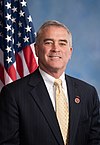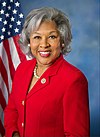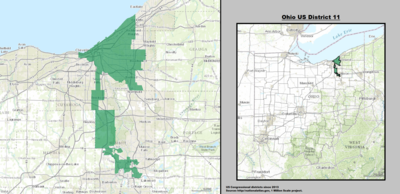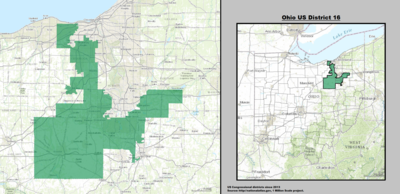Ohio's congressional districts

Ohio is divided into 16 congressional districts, each represented by a member of the United States House of Representatives. After the 2010 Census, Ohio lost two House seats due to slow population growth compared to the national average,[2] and a new map was signed into law on September 26, 2011. This map was ruled unconstitutional due to "partisan gerrymandering", and state Republicans were told to redraw the map before June 14, 2019.[3] However, on October 7, 2019, the U.S. Supreme Court dismissed the challenge to the map, allowing it to stay in effect for the 2020 election.[4]
Current districts and representatives
On May 3, 2019, a three-judge panel from the United States District Court for the Southern District of Ohio declared the Ohio's 2012 district map contrary to Article One of the United States Constitution, as "an unconstitutional partisan gerrymander" and ordered "the enactment of a constitutionally viable replacement" prior to the 2020 presidential election.[5] An appeal made to the Supreme Court resulted in the order to redraw the map being nullified.[4]
List of members of the Ohio United States House delegation, their terms, their district boundaries, and the districts' political rating according to the CPVI. The delegation has a total of 16 members, with 12 Republicans and 4 Democrats.
| District | Representative | Party | CPVI | Incumbency | District map |
|---|---|---|---|---|---|
| 1st |  Steve Chabot (R-Cincinnati) |
Republican | R+5 | January 3, 2011 – present | 
|
| 2nd |  Brad Wenstrup (R-Cincinnati) |
Republican | R+9 | January 3, 2013 – present | 
|
| 3rd |  Joyce Beatty (D-Columbus) |
Democratic | D+19 | January 3, 2013 – present | 
|
| 4th |  Jim Jordan (R-Urbana) |
Republican | R+14 | January 3, 2007 – present | 
|
| 5th |  Bob Latta (R-Bowling Green) |
Republican | R+11 | December 11, 2007 – present | 
|
| 6th |  Bill Johnson (R-Marietta) |
Republican | R+16 | January 3, 2011 – present | 
|
| 7th |  Bob Gibbs (R-Lakeville) |
Republican | R+12 | January 3, 2011 – present | 
|
| 8th |  Warren Davidson (R-Troy) |
Republican | R+17 | June 7, 2016 – present | 
|
| 9th |  Marcy Kaptur (D-Toledo) |
Democratic | D+14 | January 3, 1983 – present | 
|
| 10th |  Mike Turner (R-Dayton) |
Republican | R+4 | January 3, 2003 – present | 
|
| 11th |  Marcia Fudge (D-Warrensville Heights) |
Democratic | D+32 | November 18, 2008 – present | 
|
| 12th |  Troy Balderson (R-Zanesville) |
Republican | R+7 | September 5, 2018 – present | 
|
| 13th |  Tim Ryan (D-Warren) |
Democratic | D+7 | January 3, 2003 – present | 
|
| 14th |  Dave Joyce (R-Russell Township) |
Republican | R+5 | January 3, 2013 – present | 
|
| 15th |  Steve Stivers (R-Upper Arlington) |
Republican | R+7 | January 3, 2011 – present | 
|
| 16th |  Anthony Gonzalez (R-Rocky River) |
Republican | R+8 | January 3, 2019 – present | 
|
Historical district boundaries
-
Districts from 2003–2013
Obsolete districts
- Ohio's at-large congressional district
- Ohio's 17th congressional district
- Ohio's 18th congressional district
- Ohio's 19th congressional district
- Ohio's 20th congressional district
- Ohio's 21st congressional district
- Ohio's 22nd congressional district
- Ohio's 23rd congressional district
- Ohio's 24th congressional district
See also
- List of United States congressional districts
- United States congressional delegations from Ohio
- History of 19th-century congressional redistricting in Ohio
References
- ^ "The national atlas". nationalatlas.gov. Archived from the original on February 22, 2014. Retrieved February 22, 2014.
- ^ Wang, Robert (2010-12-21). "Census costs Ohio two seats in Congress". The Canton Repository. Retrieved 4 November 2015.
- ^ Rosenberg, Gabe. "Ohio's Congressional Map Ruled Unconstitutional By Federal Court". radio.wosu.org. Retrieved 2019-05-03.
- ^ a b "U.S. Supreme Court tosses challenge to Republican-drawn Ohio congressional maps". Reuters. 2019-10-08. Retrieved 2020-04-04.
- ^ Rosenberg, Gabe (May 3, 2019). "Federal Court Throws Out Ohio's Congressional Map". National Public Radio (NPR). Retrieved 5 May 2019.
External links
- Rose Institute of State and Local Government, "Ohio: 2010 Redistricting Changes", Redistricting by State, Claremont, CA: Claremont McKenna College

